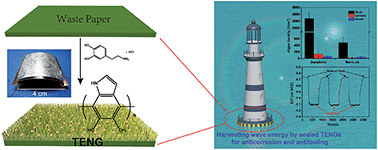Paper-based triboelectric nanogenerators and their application in self-powered anticorrosion and antifouling†
Abstract
As a smart and new energy harvesting device, triboelectric nanogenerators (TENGs) are able to convert almost all mechanical energies into electricity. However, the complex preparation process requires coating with a conductive layer, which limits their practical applications. Herein, a new type of triboelectric nanogenerator is fabricated using gum wrappers coated with aluminium foil as the conduction layer. To further enhance the output of the paper-based TENG, polydopamine molecules are introduced to improve the surface polarity of the friction layer by a simple self-polymerization reaction at room temperature. After chemical modification, the short-circuit current and output voltage are enhanced by more than 3.5 times with maximum values of 30 μA and 1000 V, respectively. The charge density increases from 21 μC m−2 to 76 μC m−2, which can light up 496 commercial LEDs. Based on the above TENGs, a self-powered cathodic protection anticorrosion system is designed to protect A3 steel from corrosion in 3.5% NaCl solution. Furthermore, the TENG powered cathodic protection system also has good antifouling properties, which can prevent algae from attaching onto metallic substrates. This work demonstrates a recyclable, cost-effective paper-based TENG, which has great potential for practical use in marine anticorrosion and antifouling.


 Please wait while we load your content...
Please wait while we load your content...